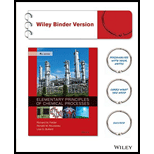
(a)
Interpretation:
Derive an expression of a and b.
Concept introduction:
Raoult’s law equation is given as,
Where, P = the pressure of the system, y = mole fraction in vapor, x = mole fraction in liquid and
(b)
Interpretation:
Calculate the mole fraction of pentane in the vapor phase for the given case and estimate a and b.
Concept introduction:
Raoult’s law equation is given as,
Where, P = the pressure of the system, y = mole fraction in vapor, x = mole fraction in liquid and
(c)
Interpretation:
Prove the given equation is valid using the materials balances.
Concept introduction:
Raoult’s law equation is given as,
Where, P = the pressure of the system, y = mole fraction in vapor, x = mole fraction in liquid and
(d)
Interpretation:
Derive the given expression.
Concept introduction:
Raoult’s law equation is given as,
Where, P = the pressure of the system, y = mole fraction in vapor, x = mole fraction in liquid and
(e)
Interpretation:
Calculate x, y, NL and nv. On a single graph plot x and y versus t for calculated Q values.
Concept introduction:
Raoult’s law equation is given as,
Where, P = the pressure of the system, y = mole fraction in vapor, x = mole fraction in liquid and
(f)
Interpretation:
Explain about the composition of the vapor and residual liquid, how the heating rate affects the system behavior.
Concept introduction:
Raoult’s law equation is given as,
Where, P = the pressure of the system, y = mole fraction in vapor, x = mole fraction in liquid and
Want to see the full answer?
Check out a sample textbook solution
Chapter 10 Solutions
Elementary Principles of Chemical Processes, Binder Ready Version
 Introduction to Chemical Engineering Thermodynami...Chemical EngineeringISBN:9781259696527Author:J.M. Smith Termodinamica en ingenieria quimica, Hendrick C Van Ness, Michael Abbott, Mark SwihartPublisher:McGraw-Hill Education
Introduction to Chemical Engineering Thermodynami...Chemical EngineeringISBN:9781259696527Author:J.M. Smith Termodinamica en ingenieria quimica, Hendrick C Van Ness, Michael Abbott, Mark SwihartPublisher:McGraw-Hill Education Elementary Principles of Chemical Processes, Bind...Chemical EngineeringISBN:9781118431221Author:Richard M. Felder, Ronald W. Rousseau, Lisa G. BullardPublisher:WILEY
Elementary Principles of Chemical Processes, Bind...Chemical EngineeringISBN:9781118431221Author:Richard M. Felder, Ronald W. Rousseau, Lisa G. BullardPublisher:WILEY Elements of Chemical Reaction Engineering (5th Ed...Chemical EngineeringISBN:9780133887518Author:H. Scott FoglerPublisher:Prentice Hall
Elements of Chemical Reaction Engineering (5th Ed...Chemical EngineeringISBN:9780133887518Author:H. Scott FoglerPublisher:Prentice Hall
 Industrial Plastics: Theory and ApplicationsChemical EngineeringISBN:9781285061238Author:Lokensgard, ErikPublisher:Delmar Cengage Learning
Industrial Plastics: Theory and ApplicationsChemical EngineeringISBN:9781285061238Author:Lokensgard, ErikPublisher:Delmar Cengage Learning Unit Operations of Chemical EngineeringChemical EngineeringISBN:9780072848236Author:Warren McCabe, Julian C. Smith, Peter HarriottPublisher:McGraw-Hill Companies, The
Unit Operations of Chemical EngineeringChemical EngineeringISBN:9780072848236Author:Warren McCabe, Julian C. Smith, Peter HarriottPublisher:McGraw-Hill Companies, The





